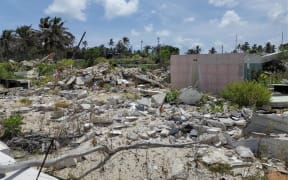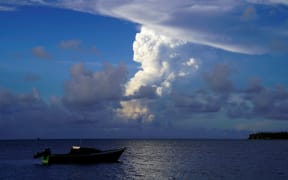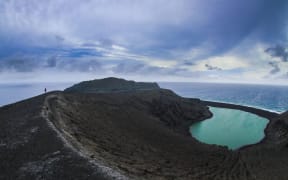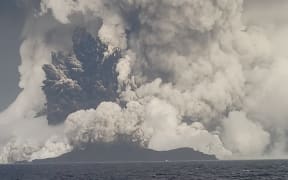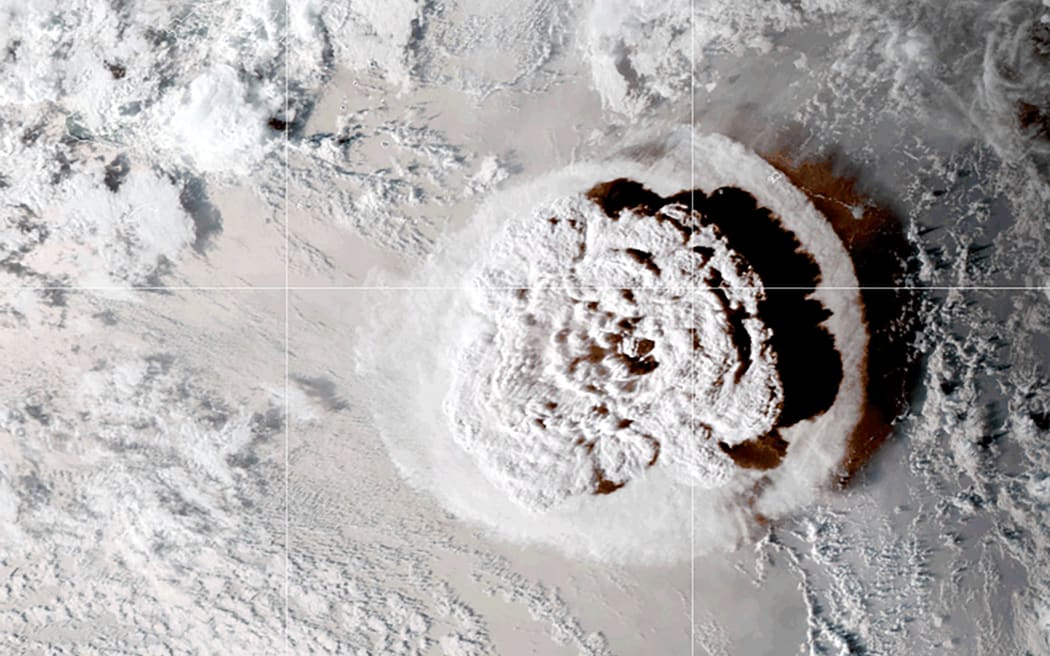
A grab taken from the NOAA GOES-West satellite on 15 January 2022 and obtained via NASA shows the eruption of the Hunga-Tonga-Hunga-Haa'pai volcano in Tonga that provoked a tsunami. Photo: AFP PHOTO / NASA / NOAA
Last year's volcanic eruption in Tonga triggered the fastest underwater debris flow ever recorded - at 122 kilometres per hour.
The research, by NIWA and the UK's National Oceanography Centre, sought to find out how the eruption of Hunga-Tonga Hunga-Ha'apai had broken underwater telecommunications cables 80km away on the seabed.
When the volcano blew, it spewed rock and ash 57km into the mesosphere.
It was when some of that material returned to earth that it rapidly spread out deep underwater, smothering everything in its path.
NIWA marine geologist and voyage leader Kevin Mackay told Morning Report the volcano "violently erupted" on 15 January 2022.
"It threw literally cubic kilometres of material into the upper atmosphere.
"As that eruption happened and was sustained, that huge volume, millions of tonnes of rock and ash and debris, suspended in the atmosphere and as the volcano explosion diminishes, it comes crashing back down under the influence of gravity, smashes into the water, into the sides of the volcano which has very steep sides and creates these what we call volcaniclastic debris density currents that just mash their way down the volcano, and that's what generated these unprecedented speeds as it demolished these communication cables."
The eruption "absolutely demolished" everything in its path and three months later while Mackay was conducting his research, cameras on the seafloor showed hundreds, if not thousands, of square km destroyed by the debris.
As well as destroying communication cables 80km away, it also destroyed the international cable which connected Tonga to the rest of the world.
Mackay said that cable was in a "completely different valley system".
"So that means these avalanches had so much energy and so much speed that they proceeded to go up and over another ridge to get to the next valley.
"It's not like water that always flows downhill, these things went off in a direction and had so much energy that they can go and flow uphill into the next valley to wipe out the international cable."
"That just shows the power and unprecedented event that happened last year off Tonga."
Mackay said this meant cable companies had to really plan for the risk that such an eruption could happen again and use that information to determine where to put replacement cables to prevent them being destroyed again.
While volcanoes are nutrient rich and can help crops grow, Mackay said so much nutrient was pumped out of the volcano and landed in the ocean that it became toxic.
"By toxic it means it's the introduction of metals, which creates plankton blooms which creates oxygen deficits in the ocean so it could take a long time for the ocean to recover from this toxic event."
It was believed the fish migrated out of the area as a result of the eruption.
"We know from commercial fisheries that they can still catch the fish they did but they're in a completely different location to where they used to be. They've just migrated."
Looking at the seafloor, Mackay said there was "huge areas" of nothing and no signs of life. It was take a long time for those ecosystems to recover, he said.
